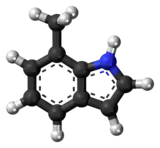 | |
 | |
| Names | |
|---|---|
| Preferred IUPAC name
7-Methyl-1H-indole | |
| Identifiers | |
3D model (JSmol) |
|
| ChEMBL | |
| ChemSpider | |
| ECHA InfoCard | 100.012.064 |
| EC Number |
|
PubChem CID |
|
| UNII | |
CompTox Dashboard (EPA) |
|
| |
| |
| Properties | |
| C9H9N | |
| Molar mass | 131.178 g·mol−1 |
| Hazards | |
| GHS labelling: | |
 | |
| Warning | |
| H315, H319, H335 | |
| P261, P264, P271, P280, P302+P352, P304+P340, P305+P351+P338, P312, P321, P332+P313, P337+P313, P362, P403+P233, P405, P501 | |
Except where otherwise noted, data are given for materials in their standard state (at 25 °C [77 °F], 100 kPa).
Infobox references | |
7-Methylindole is a mildly toxic off-white crystalline organic compound with chemical formula C9H9N.
Preparation
7-Methylindole can be prepared from 2,6-dimethylformanilide by reaction with potassium ethoxide.[1]
Uses
7-Methylindole is used in the production of agricultural chemicals and pharmaceuticals.
See also
- Indole
- Methyl
- 1-Methylindole
- 2-Methylindole (methylketol)
- 5-Methylindole
- Skatole (3-methylindole)
References
- ↑ Bass, K. C.; Nababsing, P. (1970). "7-Methylindole". Organic Preparations and Procedures. 2 (3): 221–222. doi:10.1080/00304947009458661.
This article is issued from Wikipedia. The text is licensed under Creative Commons - Attribution - Sharealike. Additional terms may apply for the media files.